air condition compressor MITSUBISHI ENDEAVOR 2004 Service Owner's Manual
[x] Cancel search | Manufacturer: MITSUBISHI, Model Year: 2004, Model line: ENDEAVOR, Model: MITSUBISHI ENDEAVOR 2004Pages: 3870, PDF Size: 98.47 MB
Page 2228 of 3870
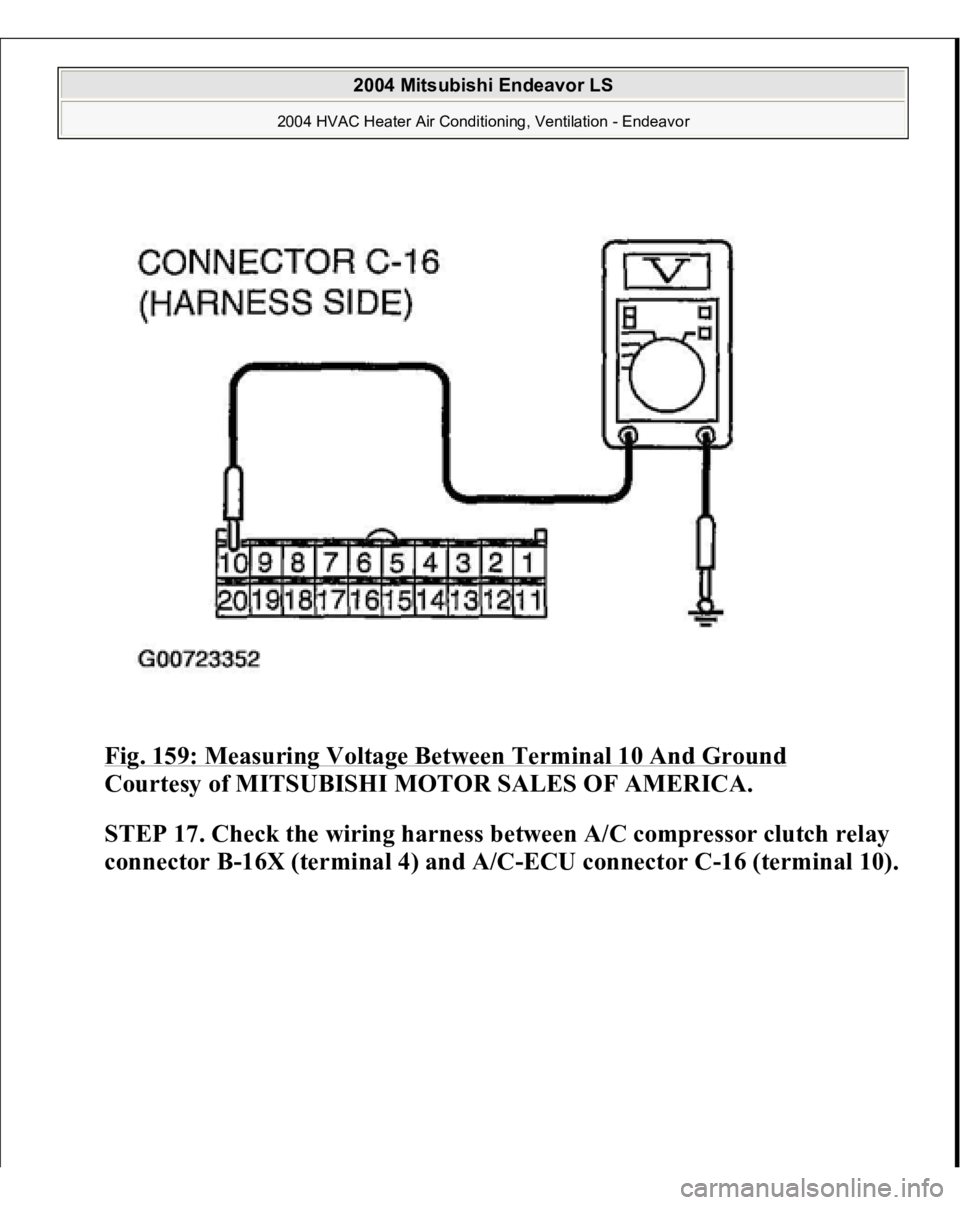
Fig. 159: Measuring Voltage Between Terminal 10 And Ground
Courtesy of MITSUBISHI MOTOR SALES OF AMERICA.
STEP 17. Check the wiring harness between A/C compressor clutch relay
connector B-16X (terminal 4) and A/C-ECU connector C-16 (terminal 10).
2004 Mitsubishi Endeavor LS
2004 HVAC Heater Air Conditioning, Ventilation - Endeavor
Page 2230 of 3870
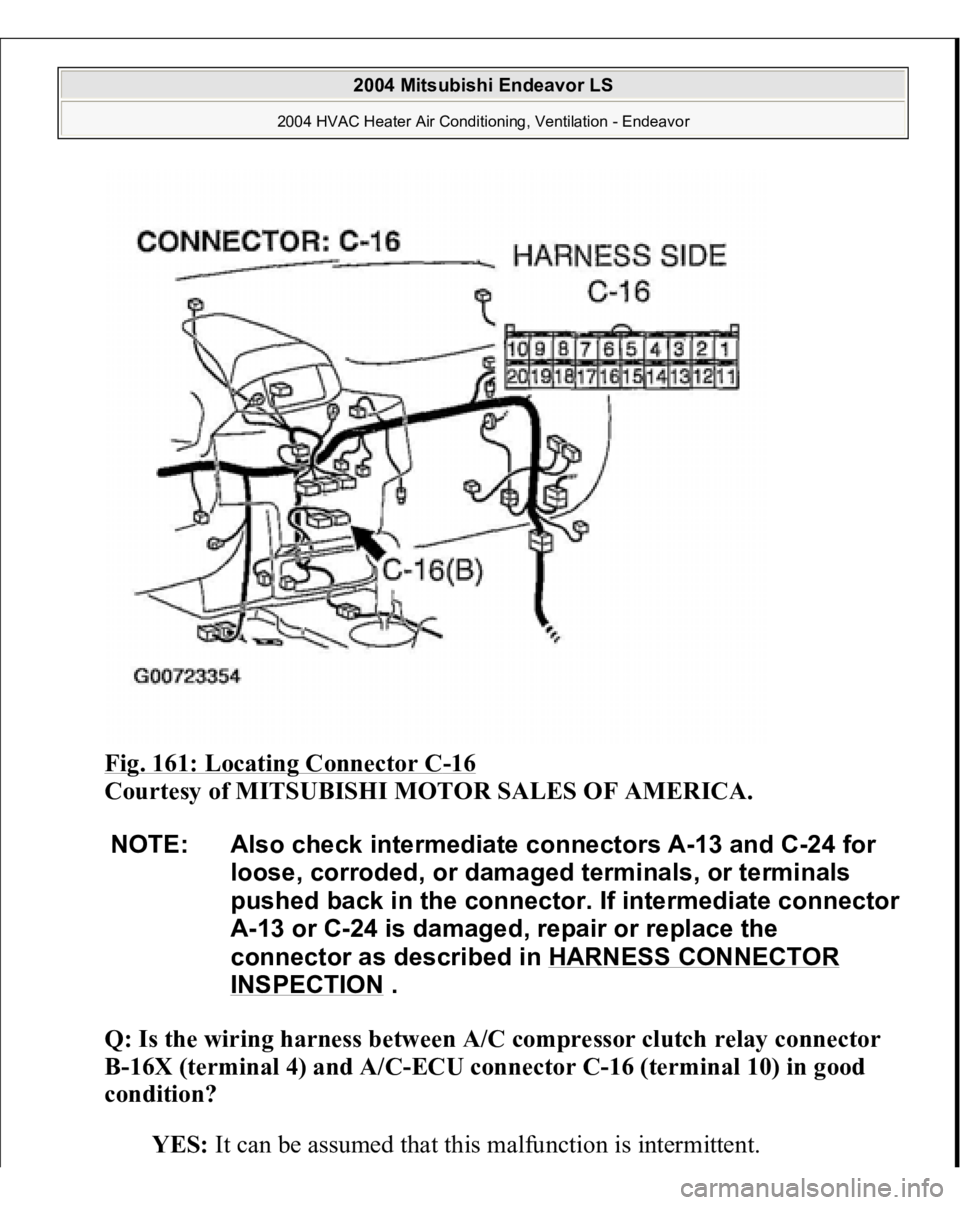
Fig. 161: Locating Connector C
-16
Courtesy of MITSUBISHI MOTOR SALES OF AMERICA.
Q: Is the wiring harness between A/C compressor clutch relay connector
B-16X (terminal 4) and A/C-ECU connector C-16 (terminal 10) in good
condition?
YES:
It can be assumed that this malfunction is intermittent.
NOTE: Also check intermediate connectors A-13 and C-24 for
loose, corroded, or damaged terminals, or terminals
pushed back in the connector. If intermediate connector
A-13 or C-24 is damaged, repair or replace the
connector as described in HARNESS CONNECTOR
INSPECTION
.
2004 Mitsubishi Endeavor LS
2004 HVAC Heater Air Conditioning, Ventilation - Endeavor
Page 2235 of 3870
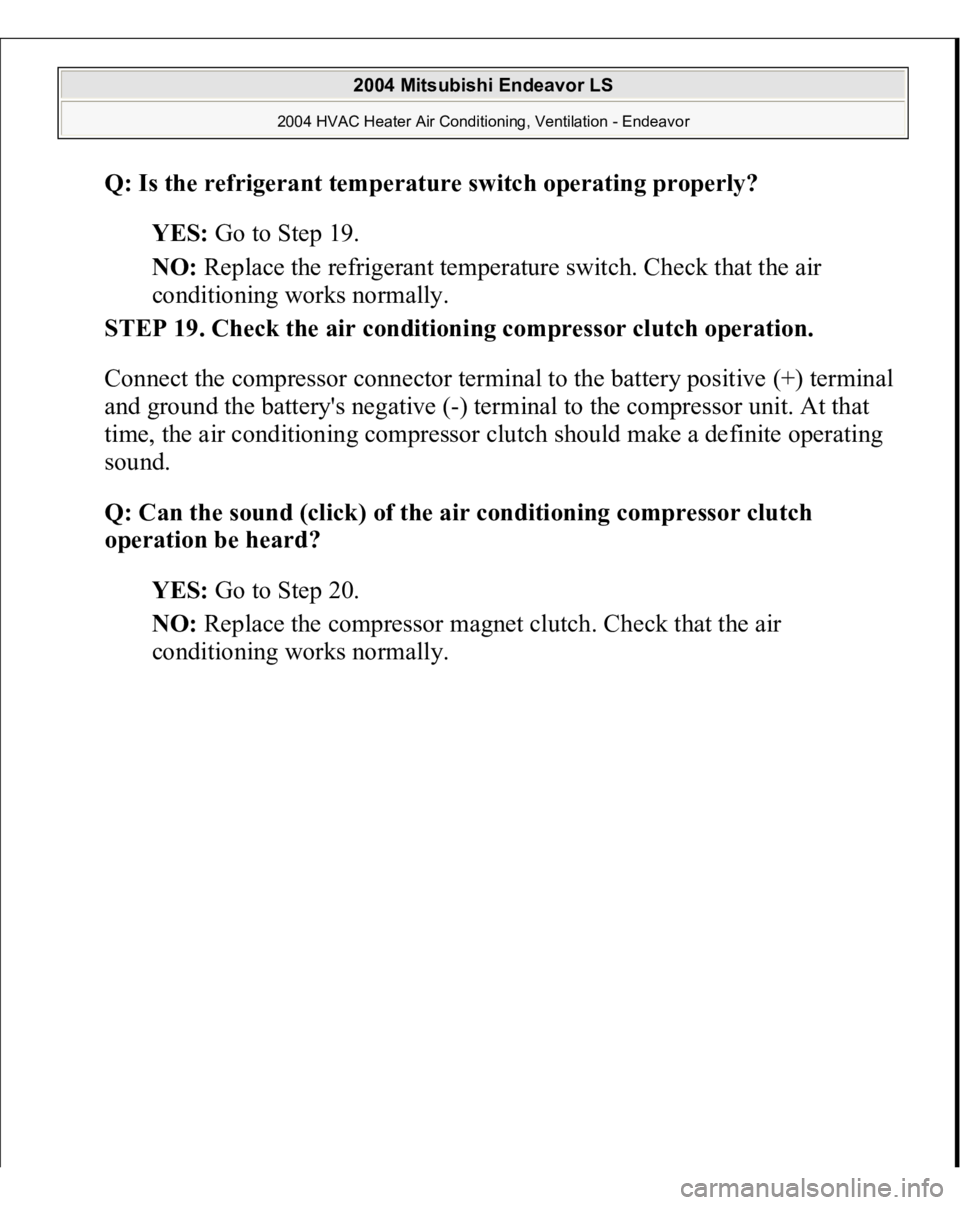
Q: Is the refrigerant temperature switch operating properly?
YES:
Go to Step 19.
NO:
Replace the refrigerant temperature switch. Check that the air
conditioning works normally.
STEP 19. Check the air conditioning compressor clutch operation.
Connect the compressor connector terminal to the battery positive (+) terminal
and ground the battery's negative (-) terminal to the compressor unit. At that
time, the air conditioning compressor clutch should make a definite operating
sound.
Q: Can the sound (click) of the air conditioning compressor clutch
operation be heard?
YES:
Go to Step 20.
NO:
Replace the compressor magnet clutch. Check that the air
conditionin
g works normall
y.
2004 Mitsubishi Endeavor LS
2004 HVAC Heater Air Conditioning, Ventilation - Endeavor
Page 2236 of 3870

Fig. 167: Checking Air Conditioning Compressor Clutch Operation
Courtesy of MITSUBISHI MOTOR SALES OF AMERICA.
STEP 20. Check the air thermo sensor.
Measure the resistance between connector terminals 1 and 2 under at least two
different temperatures. The resistance values should generally match those in
the graph.
Q: Is the air thermo sensor in good condition?
YES:
Go to Step 21.
NO:
Replace the air thermo sensor. Check that the air conditioning works
normally.
NOTE: The temperature at the check should not exceed the
range in the graph.
2004 Mitsubishi Endeavor LS
2004 HVAC Heater Air Conditioning, Ventilation - Endeavor
Page 2361 of 3870
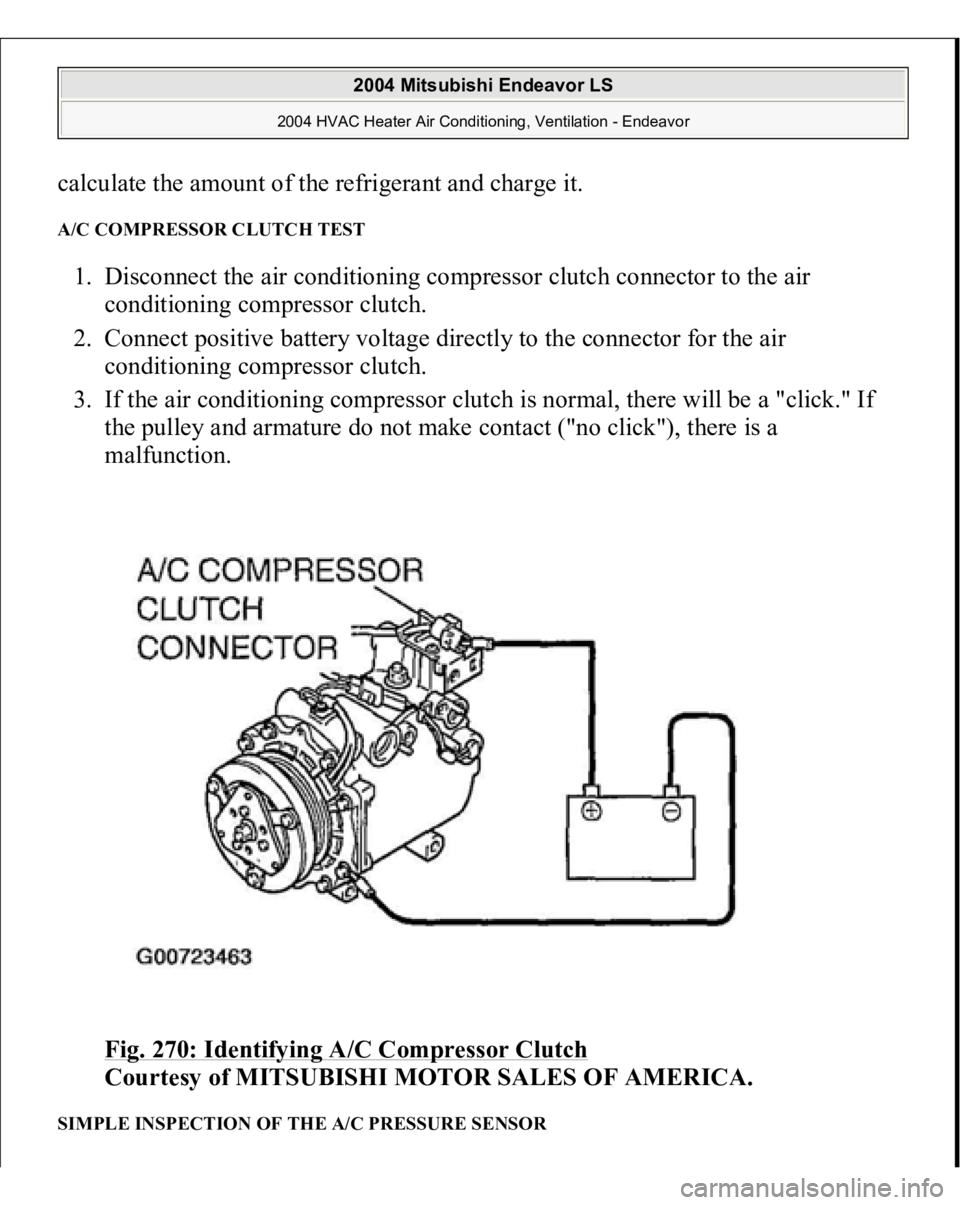
calculate the amount of the refrigerant and charge it. A/C COMPRESSOR CLUTCH TEST 1. Disconnect the air conditioning compressor clutch connector to the air
conditioning compressor clutch.
2. Connect positive battery voltage directly to the connector for the air
conditioning compressor clutch.
3. If the air conditioning compressor clutch is normal, there will be a "click." If
the pulley and armature do not make contact ("no click"), there is a
malfunction.
Fig. 270: Identifying A/C Compressor Clutch
Courtesy of MITSUBISHI MOTOR SALES OF AMERICA.
SIMPLE INSPECTION OF THE A/C PRESSURE SENSO
R
2004 Mitsubishi Endeavor LS
2004 HVAC Heater Air Conditioning, Ventilation - Endeavor
Page 2364 of 3870
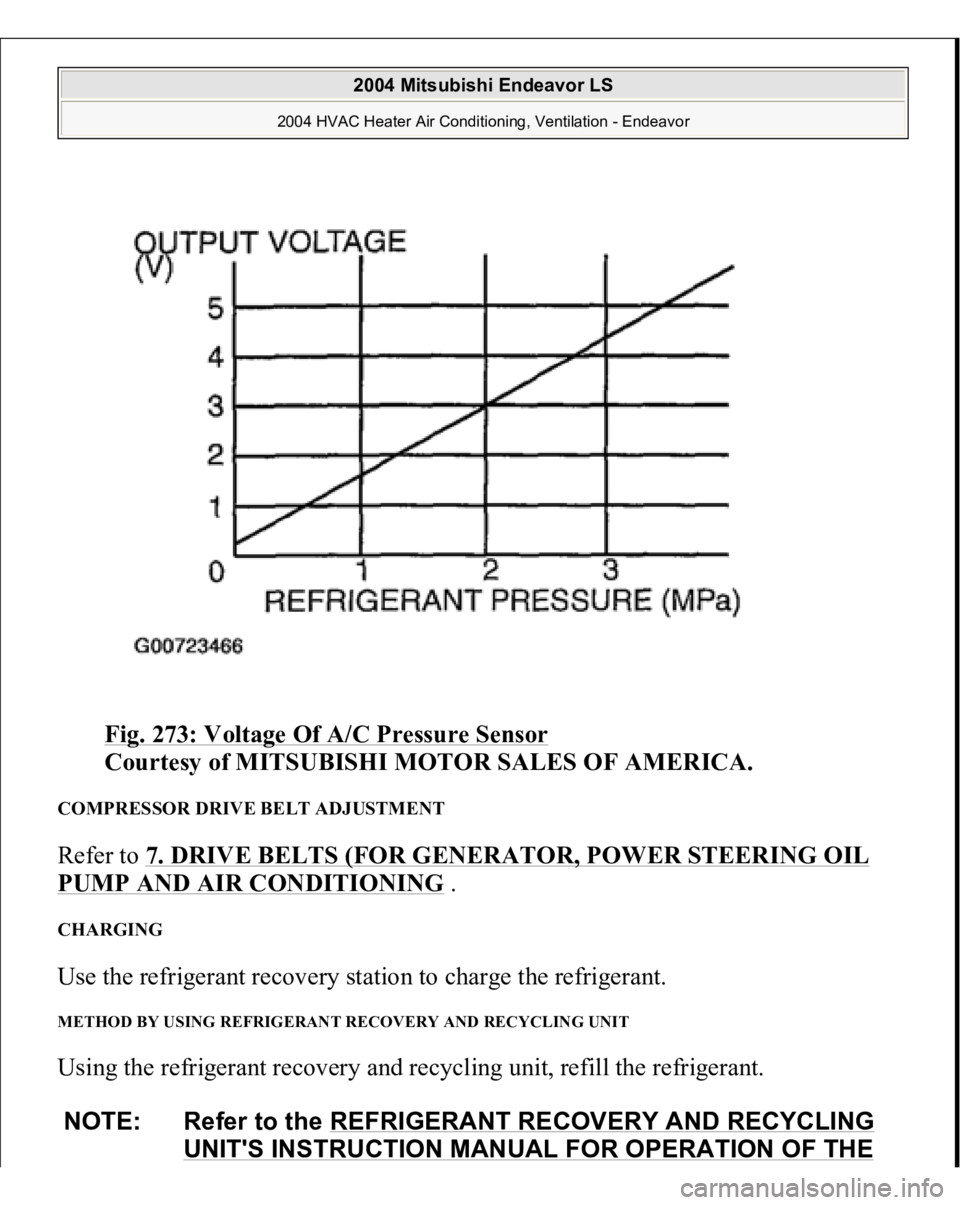
Fig. 273: Voltage Of A/C Pressure Sensor
Courtesy of MITSUBISHI MOTOR SALES OF AMERICA.
COMPRESSOR DRIVE BELT ADJUSTMENT Refer to
7. DRIVE BELTS (FOR GENERATOR, POWER STEERING OIL
PUMP AND AIR CONDITIONING
.
CHARGING Use the refrigerant recovery station to charge the refrigerant. METHOD BY USING REFRIGERANT RECOVERY AND RECYCLING UNIT Using the refrigerant recovery and recycling unit, refill the refrigerant. NOTE: Refer to the REFRIGERANT RECOVERY AND RECYCLING
UNIT'S INSTRUCTION MANUAL FOR OPERATION OF THE
2004 Mitsubishi Endeavor LS
2004 HVAC Heater Air Conditioning, Ventilation - Endeavor
Page 2365 of 3870
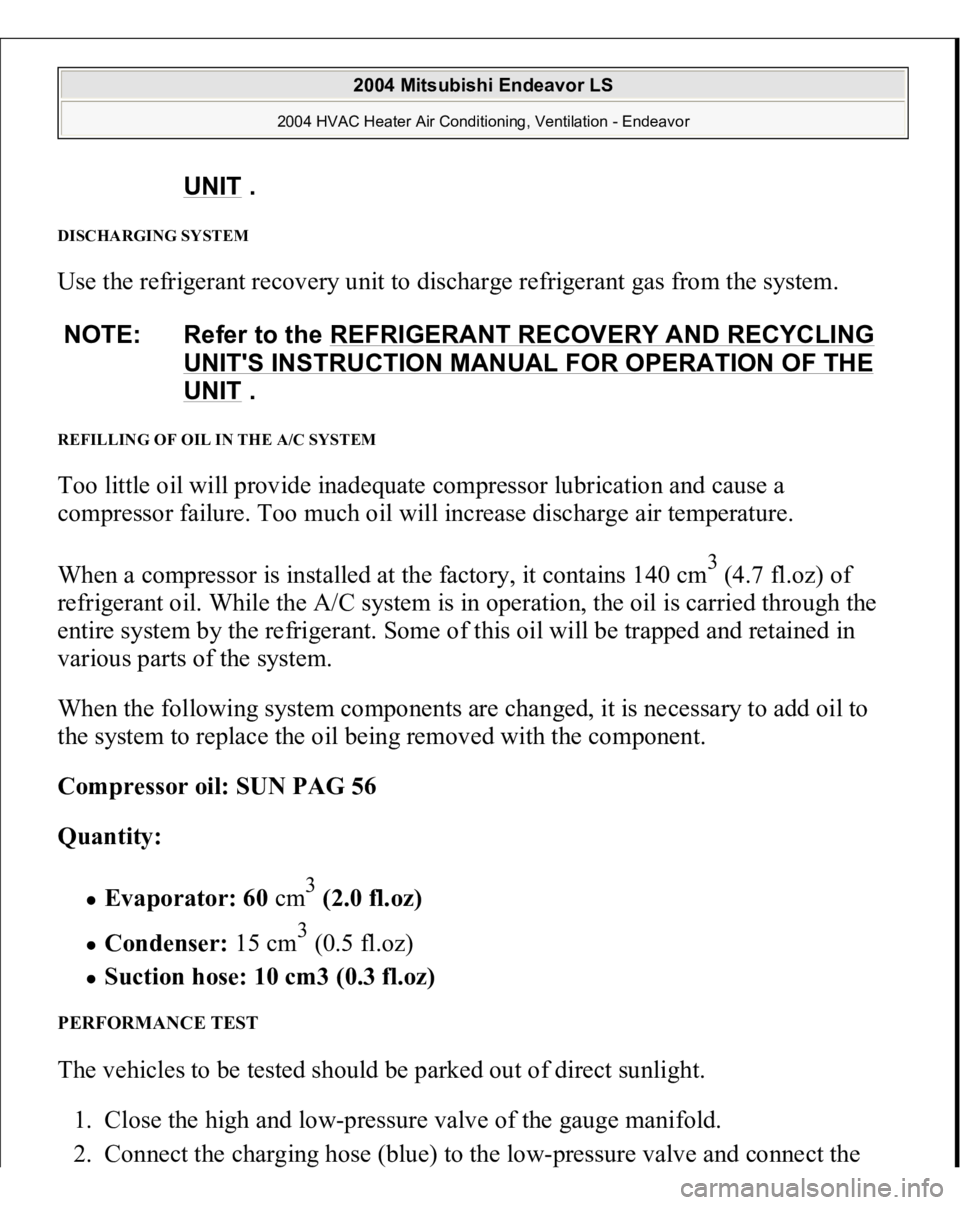
DISCHARGING SYSTEM Use the refrigerant recovery unit to discharge refrigerant gas from the system. REFILLING OF OIL IN THE A/C SYSTEM Too little oil will provide inadequate compressor lubrication and cause a
compressor failure. Too much oil will increase discharge air temperature.
When a compressor is installed at the factory, it contains 140 cm
3 (4.7 fl.oz) of
refrigerant oil. While the A/C system is in operation, the oil is carried through the
entire system by the refrigerant. Some of this oil will be trapped and retained in
various parts of the system.
When the following system components are changed, it is necessary to add oil to
the system to replace the oil being removed with the component.
Compressor oil: SUN PAG 56
Quantity:
Evaporator: 60
cm
3 (2.0 fl.oz)
Condenser:
15 cm
3 (0.5 fl.oz)
Suction hose: 10 cm3 (0.3 fl.oz)
PERFORMANCE TEST The vehicles to be tested should be parked out of direct sunlight.
1. Close the high and low-pressure valve of the gauge manifold.
2. Connect the charging hose (blue) to the low-pressure valve and connect the
UNIT
.
NOTE: Refer to the REFRIGERANT RECOVERY AND RECYCLING
UNIT'S INSTRUCTION MANUAL FOR OPERATION OF THE UNIT
.
2004 Mitsubishi Endeavor LS
2004 HVAC Heater Air Conditioning, Ventilation - Endeavor
Page 2370 of 3870
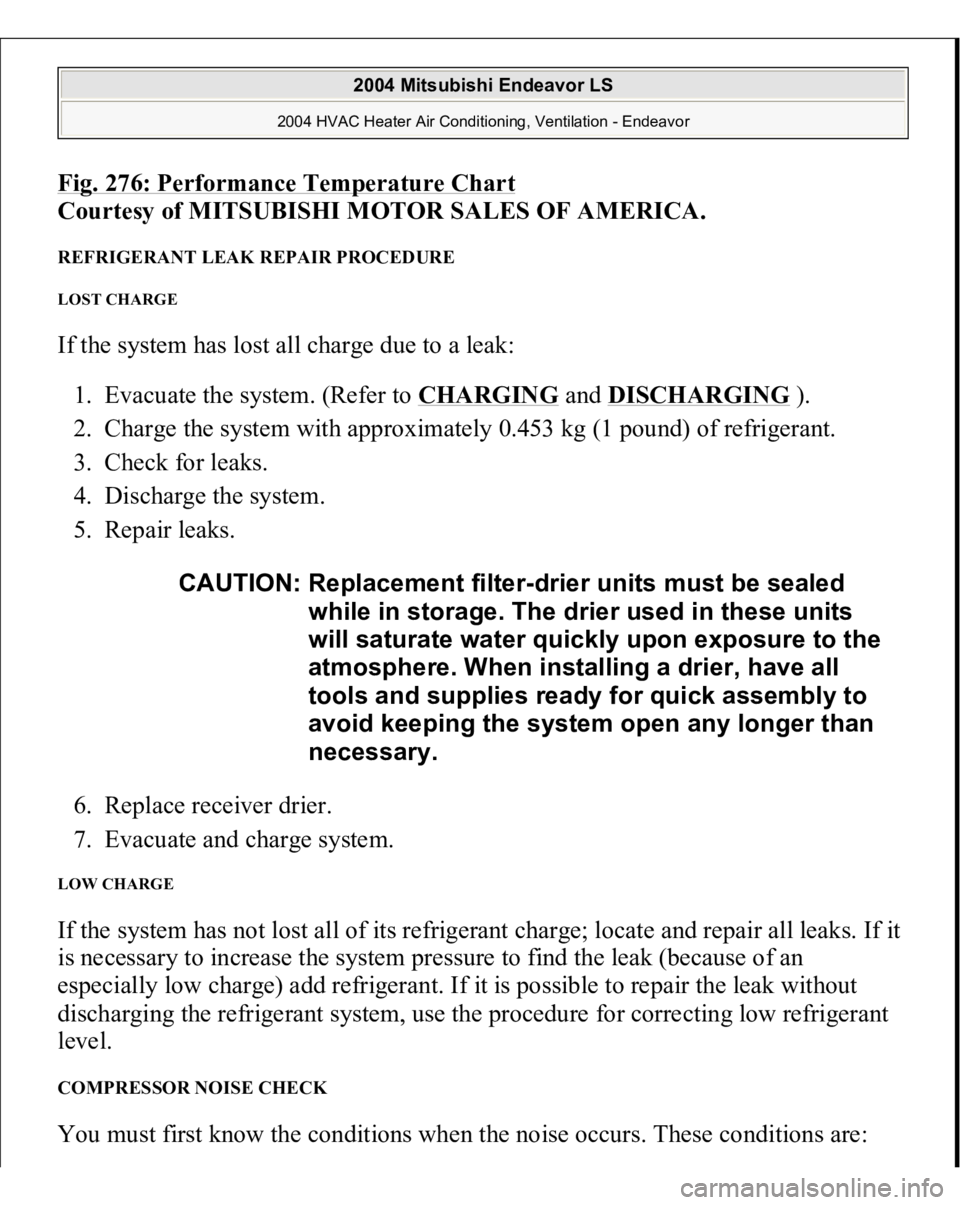
Fig. 276: Performance Temperature Char
t
Courtesy of MITSUBISHI MOTOR SALES OF AMERICA.
REFRIGERANT LEAK REPAIR PROCEDURE LOST CHARGE If the system has lost all charge due to a leak:
1. Evacuate the system. (Refer to
CHARGING
and
DISCHARGING
).
2. Charge the system with approximately 0.453 kg (1 pound) of refrigerant.
3. Check for leaks.
4. Discharge the system.
5. Repair leaks.
6. Replace receiver drier.
7. Evacuate and charge system.
LOW CHARGE If the system has not lost all of its refrigerant charge; locate and repair all leaks. If it
is necessary to increase the system pressure to find the leak (because of an
especially low charge) add refrigerant. If it is possible to repair the leak without
discharging the refrigerant system, use the procedure for correcting low refrigerant
level. COMPRESSOR NOISE CHECK You must first know the conditions when the noise occurs. These conditions are:
CAUTION: Replacement filter-drier units must be sealed
while in storage. The drier used in these units
will saturate water quickly upon exposure to the
atmosphere. When installing a drier, have all
tools and supplies ready for quick assembly to
avoid keeping the system open any longer than
necessary.
2004 Mitsubishi Endeavor LS
2004 HVAC Heater Air Conditioning, Ventilation - Endeavor
Page 2371 of 3870
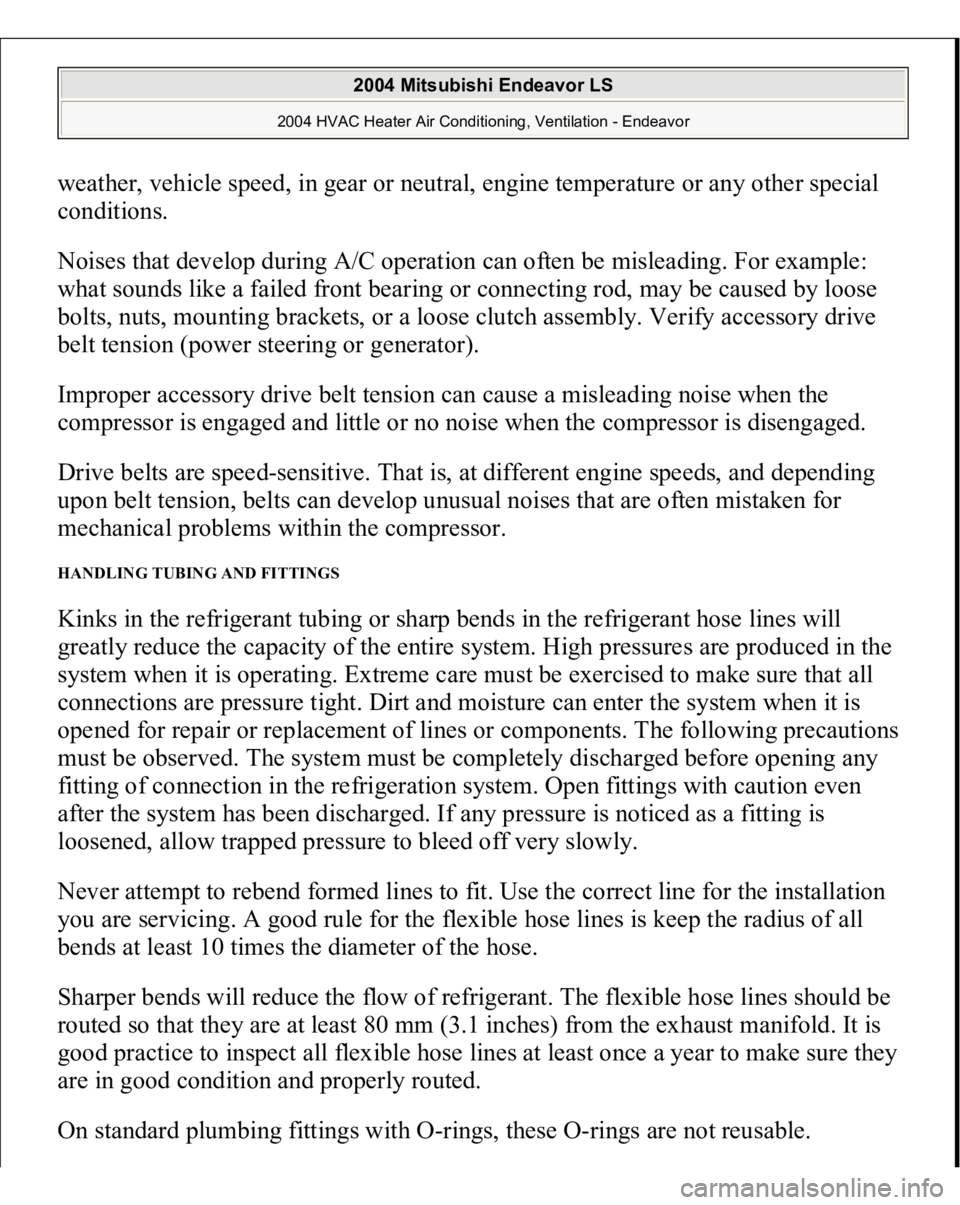
weather, vehicle speed, in gear or neutral, engine temperature or any other special
conditions. Noises that develop during A/C operation can often be misleading. For example:
what sounds like a failed front bearing or connecting rod, may be caused by loose
bolts, nuts, mounting brackets, or a loose clutch assembly. Verify accessory drive
belt tension (power steering or generator).
Improper accessory drive belt tension can cause a misleading noise when the
compressor is engaged and little or no noise when the compressor is disengaged.
Drive belts are speed-sensitive. That is, at different engine speeds, and depending
upon belt tension, belts can develop unusual noises that are often mistaken for
mechanical problems within the compressor. HANDLING TUBING AND FITTINGS Kinks in the refrigerant tubing or sharp bends in the refrigerant hose lines will
greatly reduce the capacity of the entire system. High pressures are produced in the
system when it is operating. Extreme care must be exercised to make sure that all
connections are pressure tight. Dirt and moisture can enter the system when it is
opened for repair or replacement of lines or components. The following precautions
must be observed. The system must be completely discharged before opening any
fitting of connection in the refrigeration system. Open fittings with caution even
after the system has been discharged. If any pressure is noticed as a fitting is
loosened, allow trapped pressure to bleed off very slowly. Never attempt to rebend formed lines to fit. Use the correct line for the installation
you are servicing. A good rule for the flexible hose lines is keep the radius of all
bends at least 10 times the diameter of the hose.
Sharper bends will reduce the flow of refrigerant. The flexible hose lines should be
routed so that they are at least 80 mm (3.1 inches) from the exhaust manifold. It is
good practice to inspect all flexible hose lines at least once a year to make sure they
are in good condition and properly routed.
On standard
plumbin
g fittin
gs with O-rin
gs, these O-rin
gs are not reusable.
2004 Mitsubishi Endeavor LS
2004 HVAC Heater Air Conditioning, Ventilation - Endeavor
Page 2372 of 3870
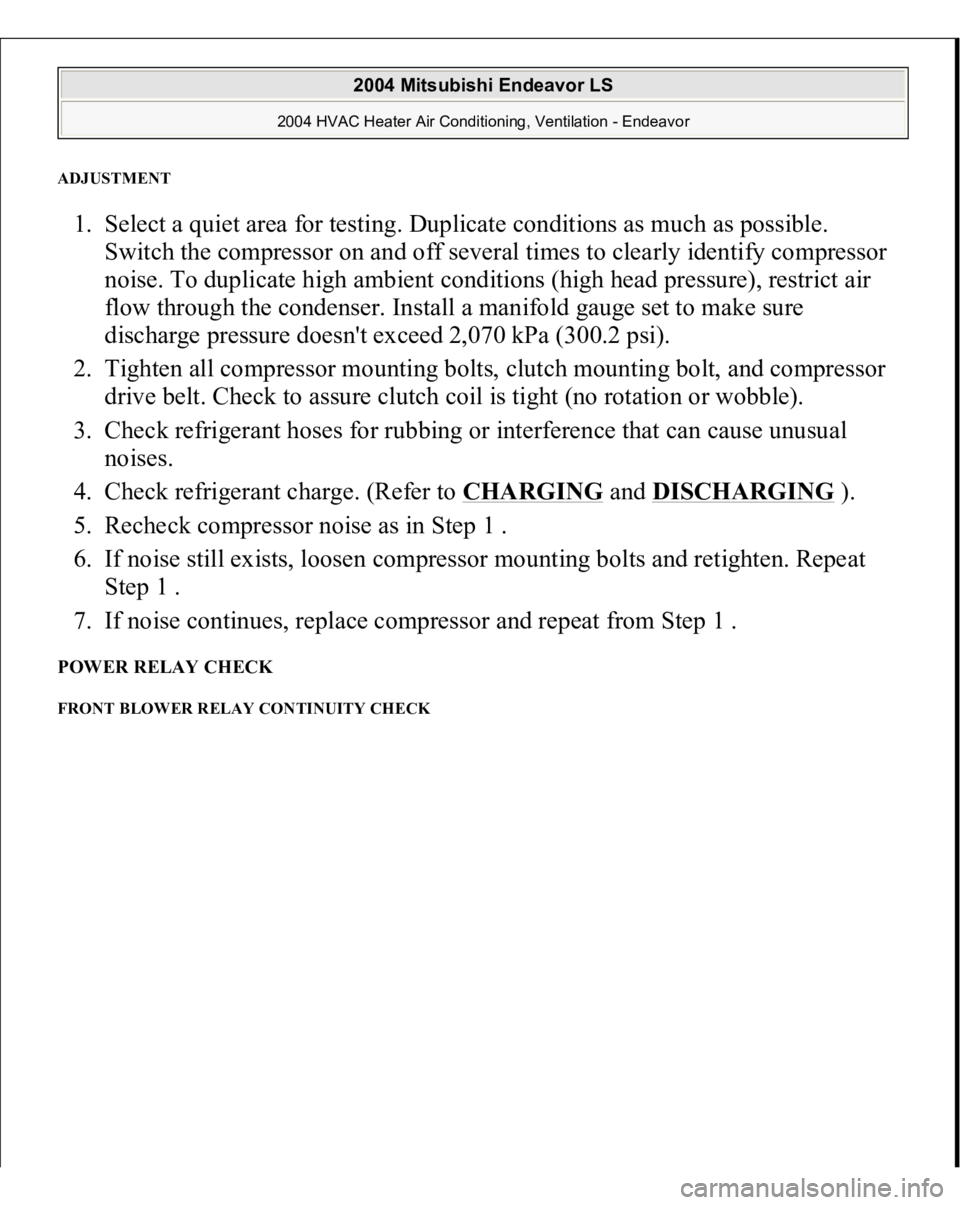
ADJUSTMENT 1. Select a quiet area for testing. Duplicate conditions as much as possible.
Switch the compressor on and off several times to clearly identify compressor
noise. To duplicate high ambient conditions (high head pressure), restrict air
flow through the condenser. Install a manifold gauge set to make sure
discharge pressure doesn't exceed 2,070 kPa (300.2 psi).
2. Tighten all compressor mounting bolts, clutch mounting bolt, and compressor
drive belt. Check to assure clutch coil is tight (no rotation or wobble).
3. Check refrigerant hoses for rubbing or interference that can cause unusual
noises.
4. Check refrigerant charge. (Refer to
CHARGING
and
DISCHARGING
).
5. Recheck compressor noise as in Step 1 .
6. If noise still exists, loosen compressor mounting bolts and retighten. Repeat
Step 1 .
7. If noise continues, replace compressor and repeat from Step 1 .
POWER RELAY CHECK FRONT BLOWER RELAY CONTINUITY CHECK
2004 Mitsubishi Endeavor LS
2004 HVAC Heater Air Conditioning, Ventilation - Endeavor